A New Composition of High Heat General Purpose Polystyrene (High Heat GPPS) Resin
JUNIPER PUBLISHERS- ACADEMIC JOURNAL OF POLYMER SCIENCE
Abstract
A new composition of high heat general-purpose polystyrene (High heat GPPS) resin synthesis is discussed. The new composition of resin involves addition of cross-linker/comonomer in very low concentration during synthesis process. Commercially available vinyl cross-linkers like divinylbenzene (DVB), Ethylene dimethacrylate (EDM), Tricycle (5.2.1.02,6) decanedimethanol diacrylate (TDDDA), Dicyclopentadiene (DCPD) and vinyl comonomer like maleic anhydride, α-methylstyrene have been evaluated via bulk polymerization method. DVB showed enhancement in the heat distortion temperature (HDT), vicat softening temperature (VST) & melt flow index (MFI) compared to the benchmark grade of GPPS, whereas other mechanical and impact properties remained same or better than benchmark grade under identical methods of measurement.
Keywords: Divinylbenzene; Cross-linked; Branching; Polymerization; Heat Distortion Temperature (HDT); Melt Flow Index (MFI)
Abbreviations: HDT: Heat Distortion Temperature; MFI: Melt Flow Index; DVB: Divinylbenzene; EDM: Ethylene Dimethacrylate; TDDDA: Tricycle (5.2.1.02,6) Decanedimethanol Diacrylate; DCPD: Dicyclopentadiene; VST: Vicat Softening Temperature; High Heat GPPS: High Heat General- Purpose Polystyrene
Introduction
Polystyrene (PS) is a multipurpose polymer used in varied applications in rigid and foamed forms. Based on orientation of phenyl group on the polymer backbone, polystyrene can be classified into isotactic, syndiotactic and atactic. Isotactic or syndiotactic polystyrene prepared by metallocene catalyst can give HDT/VST around 250 oC and shows lowest specific gravity compared to any other engineering plastics in the market [1]. XAREC is world’s first syndiotactic polystyrene commercialized by Idemitsu Corporation, used in electronic component molding [2]. The first two are commercially not important due to complexity in the synthesis and processability compared to atactic polystyrene. Atactic polystyrene is known as generalpurpose polystyrene (GPPS). It is produced by simple thermal initiated radical bulk polymerization [3]. GPPS is clear, hard and can be used in packaging, household items, and electronics. The excellent physical and processing properties make GPPS suitable for many applications as compared to any other plastics, but its glass transition temperature (Tg) is only 100 oC that leads to limit its use in certain applications. Tg dictates the continuous service temperature that is a very important factor for polymer to evaluate its processing and application performance. Therefore, there is a demand for high Tg GPPS. Some efforts have been reported in this direction by copolymerizing styrene with maleimide and imide, which act as hydrogen-bond interaction site in the copolymer [4]. Although there is no direct relation between Tg and HDT in polymers, but in amorphous polymer like GPPS, HDT is close to Tg [5].
HDT can be improved by increasing the interaction of chains or by restricting the chain mobility at elevated temperature. Although GPPS synthesis process is well established and matured, the market requirement and customer application always demand to develop new process or improve the efficiency of the process. Vinyl based anhydrides, amides, maleimides and methylstyrenes have been explored as comonomers in different loading to enhance the heat resistance of polystyrene [4-5]. This is generally achieved by introducing heteroatom containing monomer in the polystyrene chain, which leads chemical irregularity or steric hindrance in the polystyrene chain. GPPS has been widely used in food packaging containers, disposable containers, kitchenware & cutleries owing to its excellent transparency, water resistance and colorability. Molded articles prepared by GPPS with lower HDT/VST can undergo structural deformation especially when they are used in hot filled applications and lower HDT can affect the production rate during molding due to the long cycle time. Good thermal properties like higher HDT/VST along with flow are important requirement for the product performance with better heat stability & shorter cycle time in the production line. Therefore, our research was focused in first instant to increase the Tg and HDT/VST, without affecting flow properties.
Experimental Section
Material and Methods
All the chemicals that were used in the process procured from Sigma-Aldrich and used as such.
Gel-permeation chromatography (GPC)
The molecular weight of intermediate samples and final polymer was measured by GPC at 40 oC (Make-Shimadzu, Class-VP). THF was used as mobile and diluent solvent, sample concentration 2 mg/ml, column specification- PLgel 5 μm MIXED-C, 300 x 7.5 mm, Detector- UV @254nm, standards- Monodispersed polystyrene standards.
Differential scanning calorimetry (DSC)
Differential scanning calorimetry (DSC) of the samples was done with TA Instruments/DSC Q 1000 by heating the samples from room temperature to 160 ºC and heating rate always maintained at 10 ºC/min in nitrogen atmosphere.
High performance liquid chromatography (HPLC)
Unreacted residual styrene monomer was detected and quantified by high performance liquid chromatography (HPLC) Agilent HPLC-1260 series. The chromatographic condition are as follows, column- Agilent Zorbax,-C18, (4.6X150mm), 5μ; Mobile phase: Reservoir A -0.02% Orth phosphoric acid in Milli-Q water, Reservoir B-Methanol, Reservoir C - Acetonitrile at different gradients. Flow rate 1 ml/min, detector-diode array detector, wave lenth-254 nm. Column temperatue-40 oC.
Melt flow index (MFI)
Melt flow index was measured at 230 oC & 2.16 kg load as per the ASTM D 1238, in GOTTFERT MFI machine (model-MI-4).
Heat distortion temperature (HDT)
Heat distortion temperature was measured as per the ASTM D648, method B at 0.45 MPa load, on the CEAST machine. All the samples were annealed for 70 hrs. at 70 oC prior to test.
Vicat softening temperature (VST)
Vicat softening temperature was also measured in CEAST machine for annealed samples as per ASTM D1525. All the samples were annealed for 70 hrs. at 70 oC prior to test.
Mechanical property (Tensile and Izod Impact notched)
Injection molded specimens are conditioned for 48 h at 23 oC & relative humidity at 50%. Tensile strength was measured were accordance to ASTM D638, on Zwick 2.5 RTI-UTM machine. Izod impact notched was measured as per the ASTM D256.
Polymerization and Processing
Comonomer/cross linker screening
The following comonomers/cross linkers were screened in 100 g batch scale, the concentration of comonomer was maintained at 0-5 wt. %.
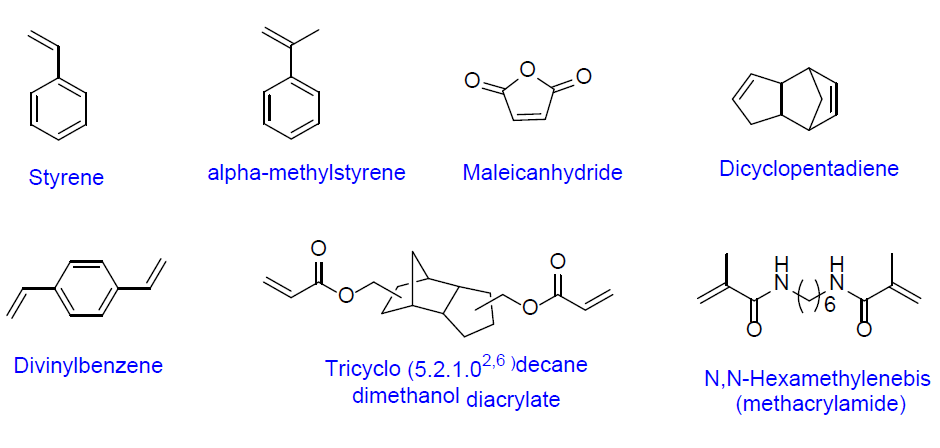
Styrene with comonomer was transferred to the pre-heated (128 oC) glass reactor, the residence time/reaction time and temperature were increased at four different time intervals to make a continuous process. Intermediate samples were collected to monitor molecular weight, Tg and conversions at every 1 h interval. Unreacted styrene monomer or residual monomer was removed by precipitating polymer solution (in THF) in hexane and then measured Tg.
Scale-up (1kg) in lab glass reactor setup
Following three formulation were shortlisted for scale-up in 1kg scale in the lab glass reactor setup (Figure 1 SI) based on the screening experimental results and evaluated thermal, flow & mechanical properties. The reaction conditions were kept as in Table 1. The unreacted styrene was removed by applying high vacuum (0-30 mbar) for 10-12 min at the end of the polymerization.
a. High molecular weight GPPS (Mw > 300 kg mol-1)
b. Evaluation of cross linker DVB at 100 ppm loading
c. Evaluation of comonomer MA at 5 wt. % loading

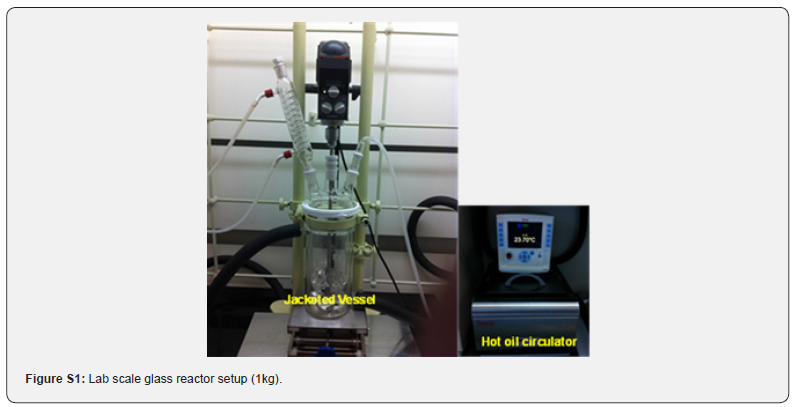
GPPS process and compounding
To evaluate the final properties of the synthesized polystyrene and copolymers were processed in different steps as shown in the Figure 1.
Results and Discussion
Different approaches to develop high heat GPPS
Based on literature search and our expertise three different approaches had been identified to achieve the targeted properties (CTQ’s).
a. High molecular weight GPPS (Mw > 300 kg mol-1)
b. Evaluation of cross linkers & comonomers
High molecular weight GPPS (Mw >300 kg mol-1)
This approach is simple and straightforward; this has been achieved by optimizing reaction time and temperature of the synthesis process as shown in the Table 2. In general, polystyrene molecular weight (Mw) can grow up to 340-350 kg mol-1 in radical bulk polymerization technique at 3-3.5 h reaction time (pre-poly), but later decreased due to thermal degradation and long residential time. In order to achieve Mw ≥300 kg mol-1, the polymerization was stopped after 4 h reaction time, with ~ 80 % conversion. At final stage high vacuum was applied for 10 min to remove 17-18 % unreacted styrene, after double extrusion the final residual was 1500 ppm.
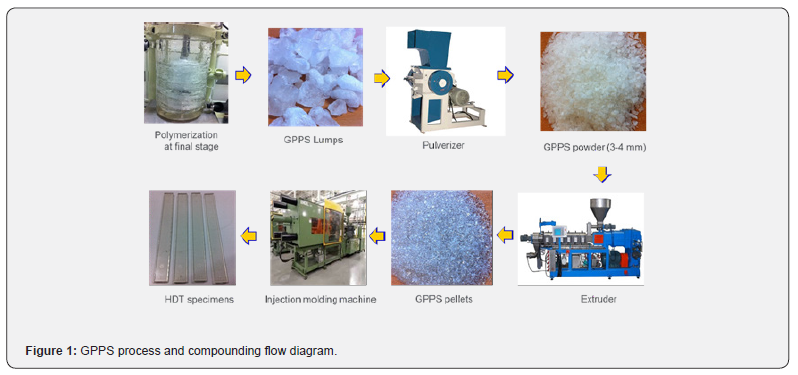
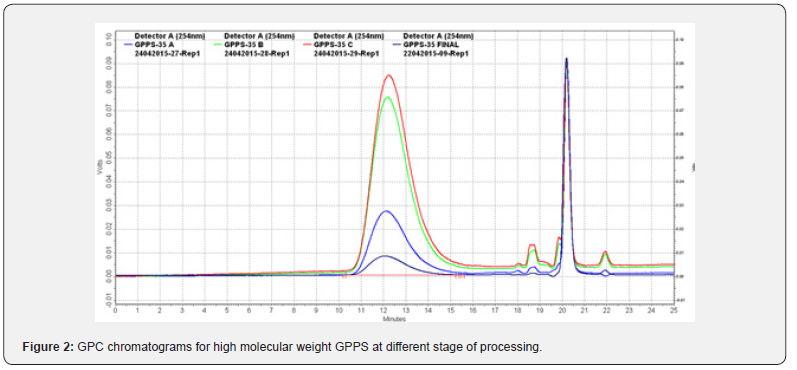
From Table 3, MFI data shows that as molecular weight increased the flow decreased, but HDT and VST increased by 2 oC. Other mechanical properties like impact and tensile properties are better or equal to the baseline material PS160. Due to the low MFI, high molecular weight approach may have negative effect on processability and cycle time during molding. Figure 2, the GPC chromatograms shows that decreased molecular weight due to thermal degradation at different stages of processing.
Evaluation of cross linkers & comonomers
Following cross linkers and comonomers were screened at different loading for high heat GPPS (Table 4) at 100 g scale. All the cross linkers were screened in the range of 50-500 ppm to avoid gelling in the reactor, whereas comonomers were tested in 1-5 wt. % loading. DVB was shortlisted for scale-up in 1kg scale and evaluated for thermal and mechanical properties as it showed better Tg (107 oC, when residual styrene ~100 ppm). Moreover, it is commercially available in bulk quantities, FDA approved and reactivity is almost similar to the styrene monomer [6-7]. The same formulation was scaled up to 5 kg scale in batch reactor in similar reaction conditions. Tricyclo (5.2.1.02,6) decane dimethanol diacrylate and N,N-Hexamethylenebis (methacrylamide) as crosslinkers did not show any improvement in Tg in the final polymer. MA showed best Tg among comonomers at 4-5 wt. % loading and was scaled up to 1 kg in lab scale. DVB loading was optimized to 100 ppm, higher loading showed low MFI (< 3.0 g/10 min) because of high molecular weight and more crosslinking. Intermediate sample analysis showed that molecular weight increased up to 3rd hour and then started decreasing (Figure 3). This is may be due to thermal degradation under dynamic reaction conditions. Styrene-DVB copolymer always gave broader PDI (≥3.0) due to partial crosslinking or chain extension/branching, which leads to higher MFI. The chain extension was envisaged by lower slope/slower relaxation in the lower frequency region in rotational rheometer study as shown in Figure 4.

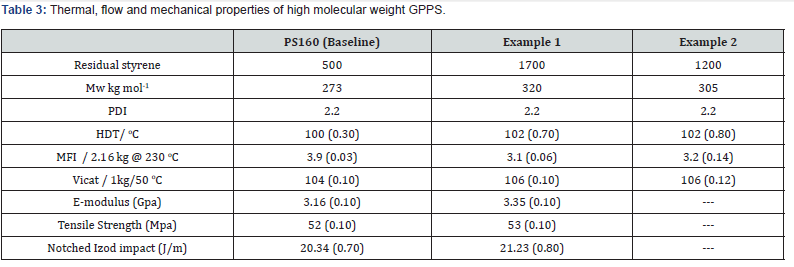
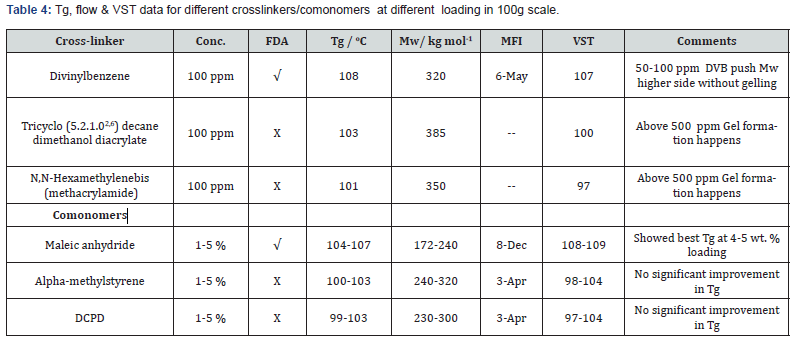
Solid content and viscosity at prepoly stage was almost similar to the homopolymer (Table 5). From Figure 7 it is very clear that residual styrene can affect Tg, that is higher the residual, lower the Tg, hence HDT/VST can also change accordingly (Table 6). It is required to maintain optimum level of (< 500 ppm, more preferably < 200 ppm as in example 2) residual in the final polymer to hit HDT > 102 oC or VST >106 oC as showed in table 6, example 2-4. The mechanical properties as if tensile strength & impact were better than the baseline PS160 (Table 6). There is no change in the thermal stability of styrene-DVB copolymer at 100 ppm DVB loading in compared to baseline GPPS PS160 (Figure 2 SI). Comonomers were evaluated in 1-5wt.% loading along with styrene, under similar reaction conditions as mentioned in the Table 2. Maleic anhydride (MA) showed HDT-102 oC, and MFI ~ 10-12 at 5 wt. % loading, but imparts haziness to the final polymer and more brittle than baseline PS 160. MA cannot homopolymerize, however in the presence of styrene it always forms alternative copolymer. This is may be due to higher activity of MA (0.02 time higher than styrene) [8].
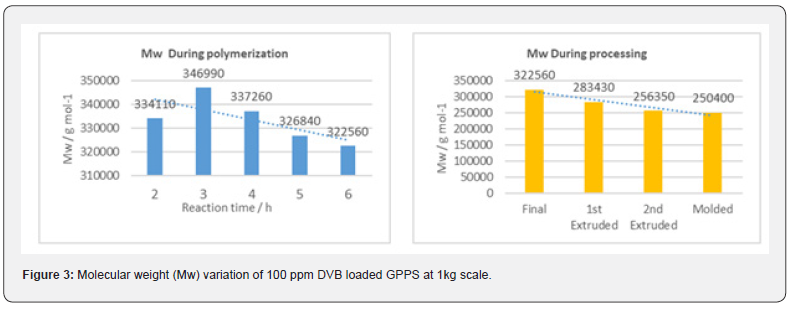

Since, we are restricted ourselves to MA content to 5 wt. % maximum in the formulation, MA was added slowly over 1 h time in the prepoly stage and anticipated fair distribution throughout the chain. As MA content increased in the formulation the copolymer molecular weight decreased below critical molecular weight (~240 kg mol-1) as showed in the Table 7 & Figure 9. As 5 wt. % loading showed Tg~ 108 oC (Figure 10), the same was scaled up to 1kg in the lab reactor and evaluated for the mechanical and thermal properties. In styrene-MA copolymerization, the propagating chains were styrinic in nature because the maleic anhydride radicals undergo chain transfer reaction in this highly reactive system [9]. The styrene-MA system was highly exothermic compared to styrene homopolymerization and styrene-DVB system. This is because hydrogen abstraction from the maleic anhydride radical is 40 kJ/ mol more exothermic than that of styrene radical. This finally leads to inferior mechanical properties compared to the baseline as shown in the Table 7. Other comonomers like alpha-methylstyrene and DCPD did not show considerable improvement in thermal or flow properties up to 5 wt. % loading.



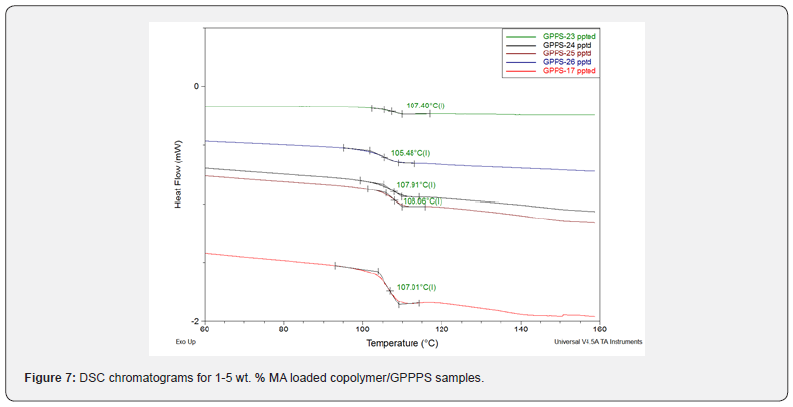
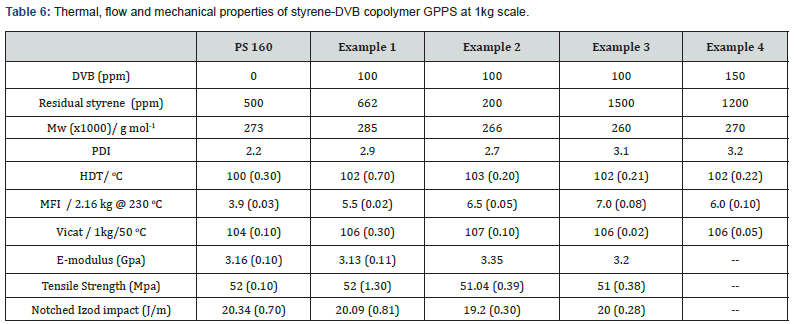


Conclusion
Divinylbenzene (DVB) as a crossliker at 100 ppm loading showed balance of thermal and flow properties as compared to baseline PS160. The controlled crosslinking of polystyrene chains by DVB play major role in broad distribution of molecular weight and hence better flow (MFI). There is an increment in the HDT/ VST by 2-3 oC and MFI from 3.3 g/10 min to 7 g/10 min without compromising any other properties of GPPS.
For more Open Access
Journals in Juniper Publishers please click on: https://juniperpublishersblog.wordpress.com/
For more articles in Academic Journal of Polymer Science please click on: https://juniperpublishers.com/ajop/index.php

Comments
Post a Comment